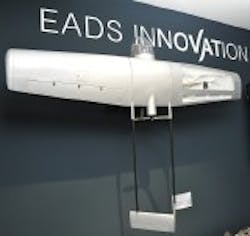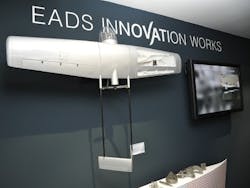EADS, Leeds U build drone aircraft with additive manufacturing
(Updated 7/13) Farnborough, UK -- EADS, the parent company of aero companies Airbus, and students from Leeds U. in the UK have developed a portable unmanned aerial vehicle produced by additive layer manufacturing (ALM). The 1.5 m wingspan plane, on display at this week's Farnborough International Air Show, is controllable via wireless video communication "over a short distance" and powered by batteries. Potential applications include surveillance, search and rescue, or disaster control scenarios.
EADS has been delving into ALM to make fixtures and tooling for its Airbus planes, and applications in its other aero divisions Eurocopter and Astrium. ALM-built parts can typically be up to 65% lighter than parts made with conventional methods, the company notes. The prototype is built with PA2200, a polyamide 12-based fine powder.
With this particular drone aircraft, four students from Leeds University's Faculty of Engineering optimized the design of its topology and aerodynamics, including weight, stability, angle of incidence and angle of twist -- yet it also had to be cheap to produce. Thanks to ALM, several sets of (for example) wings with optimized aerodynamics can be tailor-made for specific missions "at a reasonable price," they say.
The EADS/Leeds UAV also was designed with larger open spaces on the fuselage and a larger-profile wing, to take advantage of future propulsion systems -- such as the lightweight hydrogen fuel cells currently under development at EADS Innovation Works (which operates the overall organization's R&D labs). These new fuel cells could triple the plane's continuous flight endurance to six hours vs. existing battery systems.
A flight-capable metallic version of the UAV will be made at EADS Innovation Works in Filton, UK, using direct metal laser sintering (DMLS) technology, created with EADS' proprietary "Scalmalloy" material -- a modified AlMg alloy (aluminum, magnesium, scandium, and zirconium) designed to offer high strength and toughness with high fatigue properties and corrosion resistance. It is expected to take about 12-18 months to complete.
EADS also has another ALM creation on display at this week's Farnborough show: a laminar flow device, also built with Scalmalloy, which can be mounted on an aircraft wing section to remove the turbulent boundary layer of the attachment-line flow of the wing's leading edge. Enabling laminar flow over large portions of a swept wing reduces skin friction drag and thus reduces fuel consumption.

